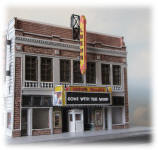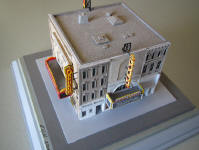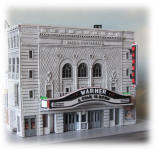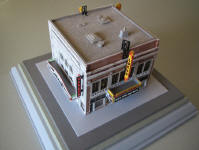|
From the earliest days of silent movies, Memphis was considered a major "movie
town". As the city grew, plush movie palaces opened downtown and every
neighborhood seemed to have its own unique theater. As Memphis began
spreading out, multiplexes soon opened in every shopping mall. This, along with
the increasing popularity of television, started the decline of the downtown and
the neighborhood theaters. Almost all of these original movie theaters eventually
closed and regrettably, all of the major theaters in
downtown Memphis have been demolished except the Orpheum. This miniature
is a tribute to 4 beautiful Memphis Theatres.
WARNER THEATRE .
Opened 1920 .
2300 Seats . Closed and Demolished 1968.
|
Originally known
as the PANTAGES, the Warner Brothers bought the building from Pantages
about 1928. The lobby was very small: really only a rear-of-house cross
aisle. Built during the regrettable era of Jim Crow laws, there were two
balconies - a large balcony for the white folks and above that the
"colored only" balcony. It was considered the grandest theater in town. A
brilliantly lighted marquee stretched the full width of the gleaming
white, terra-cotta facade, and every inch of the interior was covered in
ornate, gilded plasterwork. The building was demolished in 1968 for a bank
skyscraper.
This beautiful building
in its open setting with that grand marquee, was the most photographed of
all the Memphis theatres. |
LOEW'S STATE
. Opened 1920 .
Closed 1970 . 2566 Seats . Demolished 1972
|
Loew's State was actually built into an
older warehouse with a front entrance on Second Street. Second Street
wasn't a suitable address for such a prestigious theater so Loew's
acquired a single storefront on Main Street which aligned with the
warehouse/auditorium on 2nd. Unfortunately, there was an alley between the
two buildings which the City of Memphis wouldn't allow Loew's to close
off. The solution? The storefront was gutted and turned into a lovely
half-block-long lobby which ended in a single grand stairway which rose to
a level high enough to allow a bridge over the alley to enter the
auditorium. This all marble entrance was lined with mirrors and
crystal chandeliers and was an impressive walk to the auditorium. The State had a vaudeville
stage and pit and the hall was never renovated during its life and so
retained all it's Thomas Lamb "Loew's Adam" decor to the end. The two big
Loew's theaters in downtown Memphis were under construction at the same
time. Loew's State became notable for being the place where Elvis
Presley got his first job, in 1948, as an usher and later being fired, and
then re-instated. |
LOEW'S PALACE
. Opened 1920 .
Closed 1977 . 2200 Seats . Demolished 1985
|
Loew's Palace had a fairly small lobby
with stairs on each side. There was a glass window wall between the lobby
and the auditorium. Beyond the window wall as an open orchestra
foyer/standee area. Above this was an under-balcony dome. Ascending the
stairs led one to an lower balcony cross aisle with a well at the dome.
Looking down into the well, one looked down on seats. Looking up one saw
the saucer (under-balcony) dome. This whole lower balcony cross-aisle was
cove-lit in pink neon. Loew's Palace was the Memphis Cinerama movie
house. |
ORPHEUM
. There's
been a major Memphis Theatre on the corner of Main and Beale for over 122 years.
| .
Grand Opera
1890-1900 |
|
.
Hopkin's Grand Opera
1900-1907 |
|
. Orpheum
1907-1923
(burns) |
|
.
Orpheum
(new)
1928-1940 |
|
. Malco
1940-1977 |
|
.
Orpheum
1977-1982 |
|
. Orpheum
(Refurbished-reopened) 1984 - |
| |
|
The
Grand Opera
House
opened at the famous corner in 1890 and was touted as the finest opera house
outside New York City. In 1899, it was renamed
Hopkins Grand Opera.
The new owner hired his own resident Stock Company, and went about changing the
house into a Vaudeville Theatre. He replaced the gas lighting with 586 sparkling
lights and changed the color of the foyer from a drab olive to a brighter gray
and gold. He completely renovated the house in 1903 and the color scheme was
changed again to rose and gold, with the boxes accented with green and yellow.
Although the great Sarah Bernhardt performed here, the primary fare was
Vaudeville.
In
1907 the theatre officially became part of the Orpheum circuit and was renamed
the Orpheum
Theater.
In 1923, a fire broke out during a vaudeville show and the old Orpheum Theater
burned to the ground. Five years later, on the foundation of the old theater, a
New Orpheum
Theater was
built at a then-staggering cost of $1.5 million. This is the Orpheum that we
know today. It was twice as large as the old
theater, and much more ornate and luxurious, decorated in the style of Francois
I, the Memphis Orpheum was beyond anything the builders of the old opera house
could have ever dreamed, with brocade draperies, enormous crystal chandeliers,
gilded moldings, and a mighty Wurlitzer organ. It opened on November 19,
1928. The auditorium, which seated 2500, was decorated in shades of gold, red
and cream, and included a huge stage, orchestra pit, balcony and domed ceiling.
The grand lobby had twin staircases, enormous crystal chandeliers and gilded
plasterwork. The Orpheum Theater also contained a nightclub called the Broadway
Club, as well as smaller lobby spaces to the sides of the grand lobby.
By 1940, after
the heyday of vaudeville, the Orpheum Theater was purchased by the Malco
chain and switched to a movies-only format. The renamed
MALCO Theater
continued to run first-run films until it closed in 1977. After the
closure, there was even talk of demolishing the old theater to build an
office complex. In 1977, the Memphis Development Foundation purchased the
Malco, restored the
Orpheum
name and
began bringing Broadway productions and concerts back to the Theatre.
Fifty-four years
had taken a toll on the grand old Theatre. It closed in 1982 to begin a $5
million renovation to restore its 1928 opulence after decades of decline.
In January 1984, a grand reopening ceremony was held, which signaled the
rebirth of entertainment in downtown Memphis. Today, the
theatre is named the
Orpheum Theater
and is Memphis' premier venue for touring Broadway shows. The Orpheum
Theater has hosted more touring Broadway productions than any other
theater in the US. In addition to its stage shows, the Orpheum hosts
concerts, and is the home of the
Memphis Ballet and the Memphis
Opera. |
=<><><>=
Artist Gene
Gill lived in Memphis for his first 21 years, and like many Memphians visited
one of these theatres twice a week. He was fond of the grand old theatres.
This miniature is the second that he has built of buildings that are no longer
in existence. Memphis' original Cossitt Library was the first. |








